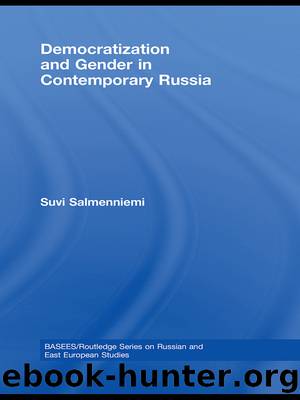Democratization and Gender in Contemporary Russia by Suvi Salmenniemi

Author:Suvi Salmenniemi [Salmenniemi, Suvi]
Language: eng
Format: epub
Tags: Ethnic Studies, Democracy, Political Ideologies, Social Science, Political Science, Regional Studies, General
ISBN: 9781134069057
Google: L9R9AgAAQBAJ
Goodreads: 17476369
Publisher: Routledge
Published: 2008-05-20T00:00:00+00:00
History of the Russian trade union movement
The trade union movement went through profound changes as a result of the demise of the Soviet system. Most unions, including the TUHW, survived this change and continue their work today. During perestroika, new alternative trade unions also emerged around certain professions (Ashwin and Clarke 2003, 1â3), but the traditional unions held out and today the absolute majority, 95 percent of unionized workers, are still represented by these unions (Kubicek 2002, 608).3
Soviet trade unions were governmental organizations subject to the Party-state. They were not based on workersâ self-organization, and membership in them was obligatory. Trade unions as all other societal organizations in the Soviet Union were organized hierarchically from the top down and had an all-Union, Moscow-led organization structure. Unions were organized on the basis of individual branches and not profession. Unlike many Western trade unions, Soviet unions also included the management in their membership. This stemmed from the conviction that there could not exist any contradictory interests between workers and the management, as the Soviet system had abolished the antagonism between labor and capital, and every citizen was to work for the benefit of the state. Because of this, unions could not articulate a conflict between the workers and the management if one arose. The workers were linked to the labor collective as supplicants of benefits and objects of various measures, not as political subjects. In this sense the labor collective was for them at the same time a source of social security and a site of subordination (Ashwin 1999, 14).
Soviet trade unions had a triple role. First, they served as âtransmission beltsâ mediating between the state and masses. They were to keep up order and discipline at workplaces and monitor the fulfilment of the production plan. Second, they functioned as an ally of management and took care of the distribution of a number of work-related services and benefits, such as childcare, housing and cultural facilities, which were of crucial importance for workersâ everyday life. Thus, unions were responsible for such services that are today provided by regional and municipal authorities, private enterprises and civic organizations. In addition, unions lobbied the ministries together with the management. Third, unions were able, albeit to a limited degree, to defend workers against the management in cases of unjustified dismissals or violations of safety codes, but only within the guidelines set by the Party (Kubicek 2002, 607; Ashwin and Clarke 2003).
With the disintegration of the Soviet system, the role of the trade unions was redefined. Trade unions declared themselves as civic associations independent of the state, political parties and economic bodies. Article 2 of the Federal Law on trade unions of 1996 defines a trade union as a âcitizensâ voluntary civic association (dobrovolâ²noe obshchestvennoe obâ³edinenie) that protects and represents workersâ social and labor rights and interestsâ. Trade unions are today among the largest civic organizations in Russia, representing a major actor in the civic field. In spite of this, trade unions have often been ignored in studies
Download
This site does not store any files on its server. We only index and link to content provided by other sites. Please contact the content providers to delete copyright contents if any and email us, we'll remove relevant links or contents immediately.
| Anarchism | Communism & Socialism |
| Conservatism & Liberalism | Democracy |
| Fascism | Libertarianism |
| Nationalism | Radicalism |
| Utopian |
The Secret History by Donna Tartt(18694)
The Social Justice Warrior Handbook by Lisa De Pasquale(12069)
Thirteen Reasons Why by Jay Asher(8716)
This Is How You Lose Her by Junot Diaz(6689)
Weapons of Math Destruction by Cathy O'Neil(6068)
Zero to One by Peter Thiel(5618)
Beartown by Fredrik Backman(5533)
The Myth of the Strong Leader by Archie Brown(5358)
The Fire Next Time by James Baldwin(5185)
How Democracies Die by Steven Levitsky & Daniel Ziblatt(5083)
Promise Me, Dad by Joe Biden(5029)
Stone's Rules by Roger Stone(4981)
100 Deadly Skills by Clint Emerson(4785)
A Higher Loyalty: Truth, Lies, and Leadership by James Comey(4768)
Rise and Kill First by Ronen Bergman(4643)
Secrecy World by Jake Bernstein(4584)
The David Icke Guide to the Global Conspiracy (and how to end it) by David Icke(4539)
The Farm by Tom Rob Smith(4397)
The Doomsday Machine by Daniel Ellsberg(4366)
